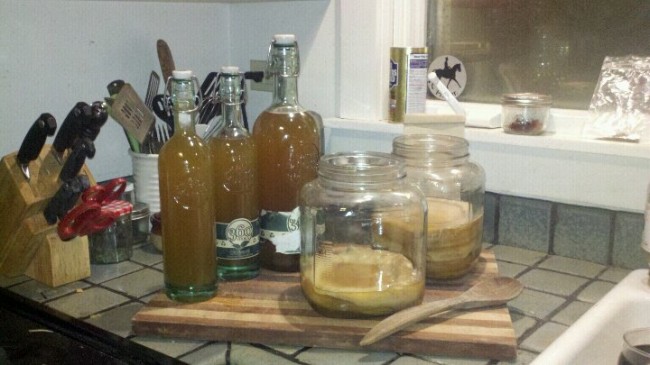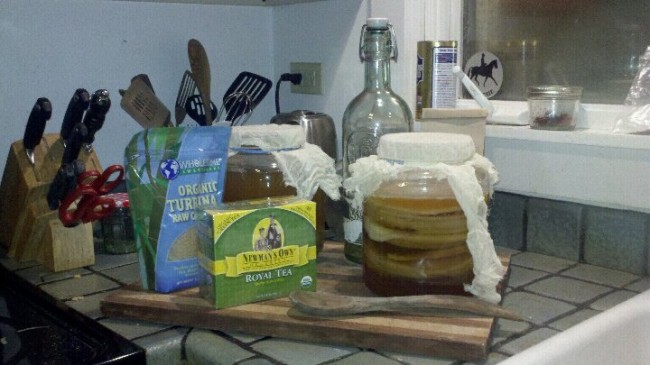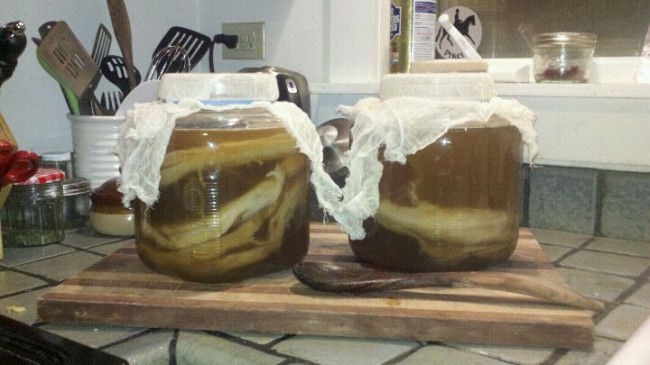When people walk into my kitchen and see my kombucha tea cultures sitting on the counter, their reaction is almost unanimously something along the lines of “what the hell is that?” – at which point I excitedly launch into my kombucha spiel, explaining the health benefits of this exciting and delicious beverage. My passionate pitch is usually met by the raised eyebrows and skeptical stares of my unconvinced friends until, that is, they actually try my home brew. It’s effervescent, crisp and surprisingly refreshing. And at almost $4 a bottle on the health food store shelf, the less than $10 weekly cost of my home-brewed batch is a lifesaver to my Ski Bum Kitchen budget.
If you’re not familiar with kombucha, it’s a fermented tea known for it’s invigorating and cleansing health properties. It is a “living drink,” meaning that it is full of active probiotic yeasts, bacteria and enzymes. It also contains organic acids, vitamins and minerals. Kombucha is made by feeding a batch of sweetened tea to a mushroom-looking culture known as a “SCOBY,” or Symbiotic Culture Of Bacteria and Yeast. This SCOBY houses a colony of healthy microorganisms, and at the introduction of sugar-laden tea, these probiotics go to work consuming their fuel, as it is, in the process of fermentation. The by-products of this enterprise are the hosts of detoxifying and pH-balancing agents that are found in kombucha tea.
I began brewing my own tea about two years ago because I couldn’t afford my (sometimes multi) bottle-a-day habit (not to mention I didn’t like the consumption/waste factor of buying so many bottles all the time). I bought an “original” flavored kombucha drink from the store, threw it into a glass container, and fed it some sweet tea. In a couple days, a thin film began to form on the top of the tea, and my first SCOBY was born.
I’ve since kicked my kombucha bottle purchasing habit, and instead I do a weekly kombucha “harvest.” My SCOBY has grown from a thin film into an alien-looking monster (as my roommate often likes to remind me), and every seven to 10 days, I make some sweetened-to-southern-palate-taste green tea and then “feed” it to my cultures. While my sweet tea is cooling, I pour off and bottle the tea from last week’s brew. When my new tea has reached a warm temperature, I pour it into my SCOBY jars, date the new brew, and cover the containers with cheesecloth so that the yeast and bacteria can “breathe.”
To enjoy my finished kombucha, I usually mix in a little juice or soda water to dilute the kick of the raw tea, which definitely has a vinegary flavor. A box of green tea, a couple cups of raw sugar, and 20 minutes of my time provide me with all the kombucha I want for the week.
So what’s the big deal? You won’t really understand what the big deal about kombucha is until you begin drinking it. I’ll admit it’s an acquired taste, but once you’re onto it, you’ll find your former sugary soda drink favorites unpalatable. And for me, it takes about a week of daily kombucha consumption before I begin to notice a huge difference in the way that my body feels. Basically, I feel great. I have more energy, my annoying face blemishes disappear, and I feel happier in my day-to-day life, somehow “lighter.” After a few weeks of a regular kombucha habit, I feel like my skin has a healthier glow (kombucha is supposed to diminish the appearance of wrinkles and fine lines). And if you’re looking to trim off those last few pounds, a kombucha downed in lieu of a snack will act as both an appetite suppressant and also an energy booster, not to mention that the “kombucha buzz” is great fun, like a super-coffee-high without the ensuing crash.
Now keep in mind that these alleged kombucha health benefits are just that – claims. There has been little scientific evidence to prove that kombucha is really good for you, and there are definite naysayers out there shouting from the hilltops that this kombucha hype is all a load of crap. But speak with any regular kombucha drinker, and I bet you’ll hear only positive reports. And really, how long does a crazy health fad have to stick around before it’s considered somewhat credible? I can’t help but believe that there must be something going on with this drink for it to have made it from the first record of the tea as the “Drink of Immortality” coming from China, circa 200-something B.C., to my Jackson Hole kitchen counter in our current year 2012. I’m just saying…














